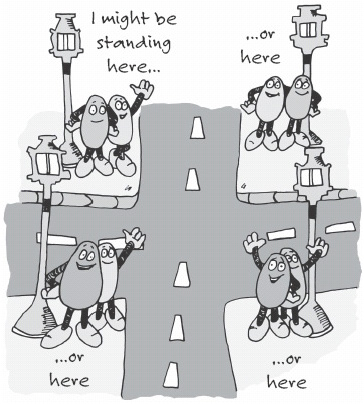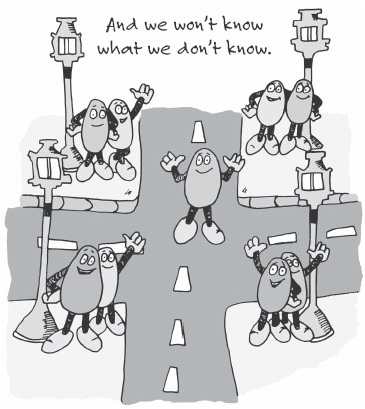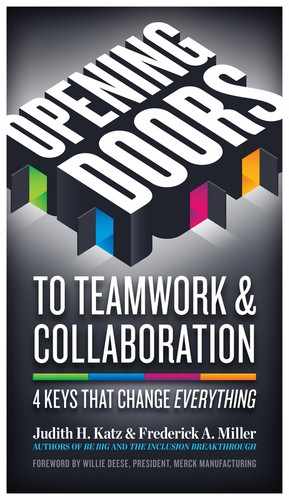Opening the Door to …. BREAKTHROUGHS
Key #4: Share Your Street Corner

CORE BEHAVIORS TO BREAKTHROUGHS
Share Your Street Corner
![]() SHARE YOUR PERSPECTIVE: recognize you have a piece of the puzzle.
SHARE YOUR PERSPECTIVE: recognize you have a piece of the puzzle.
![]() ACCEPT OTHERS’ PERSPECTIVES: as true for them.
ACCEPT OTHERS’ PERSPECTIVES: as true for them.
![]() BE CURIOUS: hear another perspective as different, not wrong.
BE CURIOUS: hear another perspective as different, not wrong.
Most intersections have four street corners. Some have even more. The challenge is to hear from all the Street Corners! Don’t assume your view is the only view, the best view, or even the correct view.

I am standing at a busy intersection, waiting to cross the street, when I hear a screech of brakes. I look up just in time to see a large black SUV plow into the rear passenger door of a red sedan, which spins around and smacks into the front left quarter panel of a parked minivan.
Fortunately, no one appears to be injured. From my vantage point on my street corner, I can see the drivers of the vehicles involved in the accident getting out of their cars, each pointing a finger of blame at the other.
Uh oh, I think. They are going to have trouble sorting this out. It looked like the SUV may have been to blame, but the red sedan may have run a traffic light. I was an eyewitness, but I really can’t say who was at fault.
Without the full range of
perspectives, we cannot be sure
we have the complete picture.

What Is the View from Your Street Corner ?
So how do the police sort things out? They start by asking themselves, “What do we need to know to figure out what happened?”
As they question the people involved in the accident and the witnesses at the scene, they do not assume that any one person can give them the full picture. Ideally, they want to get reports from witnesses on all four corners of the intersection—preferably, several from each corner, from the people crossing the street, and the people who were involved in the accident—so they get the fullest picture of what took place.
Once they gather as many viewpoints and details as possible, they come together, share what they learned, and put all the data together until a fully dimensional, 360-degree, time-sequenced picture of the incident emerges so they can solve the puzzle.
If they discover that none of them has spoken to any witnesses from the southwest corner, they may decide to go back to the scene to see if they can find more witnesses.
The reason? Even if the witnesses from the other corners have provided what seems to be a complete accounting of the accident, there would be a gap from the southwest perspective. And while it is possible that southwest-corner witnesses may have nothing new to add, there is also the very real possibility that those witnesses may have seen something that could not have been seen from any other angle.
Without accounting for all the Street Corners, they may fail to get the breakthrough information that solves the puzzle.
Without the full range of
perspectives, we cannot be sure
we have the complete picture.

We all need to be willing to share our Street Corners
There are a lot of things happening in our team. But I can’t and don’t know everything. That is why you need to Share Your Street Corner constantly—responsively and proactively—and I need to share mine. I need to ask you what you are seeing from Your Street Corner, and I need to be ready to Listen as an Ally when you share that information.
And if I think it could help you, I need to tell you about what I see from my Street Corner, even if you don’t ask.
Because so many unknowns and unknowables exist in today’s organizations, it is essential to get as many views as possible to solve complex challenges and problems. In this highly competitive marketplace, businesses can no longer afford to make many mistakes. When time, energy, and money are wasted because all the right players weren’t involved in the first place, or decisions need to be reconsidered because critical information did not get incorporated during the problem-solving process, the whole organization suffers.
We need to expand our comfort zones around who is involved, when they are involved in the process, and how their perspectives are heard.
Our First To-Do
If we want to make sure we are getting the complete picture, if we want to avoid false starts and mistakes, and if we want Right First Time decisions, actions, and interactions, the first thing to do in order to understand the situation is to make sure we hear from all Street Corners. We need to assume there is a bigger picture, and the challenge is to get input from all. That is what is required to open the door to breakthroughs.
“What gets us into trouble is not
what we don’t know. It is what we
know for sure that just ain’t so.”
—Mark Twain

The Key That Opens the Door to Breakthroughs
If I am willing to Lean into the Discomfort of reaching out to you …
If I am willing to Listen as an Ally so I can hear and appreciate the different perspectives you have to offer …
And if I am willing to State my Intent and Intensity so you and others can understand where I am coming from …
… then we have the possibility to gain from others’ Street Corners and create something new together: a breakthrough!
Even if my view is incomplete, I can’t
assume that I can’t contribute. I
have a piece of the puzzle that will
help the group to arrive at a more
complete picture of the situation.

Wrong OR Different?
I am in a meeting, and Jane expresses a different perspective from mine. It seems like she is just playing devil’s advocate again. Instead of being curious and inquiring about her position, I label her and her perspective—her Street Corner—as wrong.
She just doesn’t understand the situation, I think. We are not aligned. And I see the difference as a conflict.
Seeing Value in Differences of Opinion
When we hear someone voicing a point of view differing from our own—bringing another Street Corner—we may tell that person, either with our words or through facial expressions, to be quiet. Or we may label someone who raises conflicting issues or highlights inconvenient information as not a team player. But this is a lot like shooting the messenger.
It is easy to see a different perspective or Street Corner as wrong and to label a potential contribution as a conflict. But by doing so, we miss the opportunity to see another view that can add value, eliminate missteps, or bring our discussion to a new level of thinking.
Sometimes what sounds like
disagreement is really a
different Street Corner.

Reaching Out to New Street Corners
The idea of seeking out a Street Corner other than our own—or other than the one held widely by a team or by the team leader—is sometimes framed as just looking for trouble. Often, differences of opinion are considered disruptive. Many times organizations are so entrenched in their hierarchy that they don’t consider reaching out to other layers of the organization—areas where people may have another Street Corner or data that is crucial to the problem or decision at hand.
A lot of people, and a lot of teams, put a high value on agreement. They feel it is important for everyone to act and think uniformly. But uniformity can discourage new voices and ideas and hinder breakthroughs.
By insisting that everyone agrees, thinks the same way, and acts the same way, we might miss the 360-degree vision we need. We fall into groupthink and sameness.
As in a chemical reaction, the stimulus for higher achievement and innovation comes when the catalyst is added—bringing in new or different Street Corners.
I Need to Hear Your Street Corner
The work-teams at a large manufacturing site were reorganizing their processes in an effort to improve quality and productivity. The plant’s future depended on these efforts; everyone’s job was at stake.
People in frontline and operator-level positions were not accustomed to being asked to offer their opinions to their supervisors or managers. But they had all been working on changing the organizational interactions using the 4 Keys.
In one department’s work process meeting, the team leader asked the frontline team members to provide input saying, “I need to hear your Street Corners to improve these processes.”
Because of their work with the 4 Keys, everyone knew this statement meant: “Your point of view is important to our information-gathering and decision-making process. I need your honest, unvarnished view of the situation. Please don’t just tell me what you think I want to hear!”
As a result, team members spoke up and the group was able to implement a series of process changes that improved productivity significantly. It was indeed a breakthrough for the department and the plant. Part of that productivity gain was attributed to the entire team’s sense of ownership because they were willing to Lean into Discomfort, Listen as Allies, State Intent and Intensity, and Share their Street Corners.
So What’s Stopping You from Wanting to Share Your Street Corner ?
“My Street Corner isn’t very important.
I am new here. I don’t have the
experience of the other people.”
“Asking for other opinions just wastes my
time. Let us just agree to disagree and get on
with it. We have deadlines to meet!”
“Too many perspectives just lead to
conflict. I can’t afford endless argument
and debate. It takes too much time.”
When you Share Your Street Corner, it
isn’t just making sure all perspectives
are heard. You also need to make
sure you are open to joining Street
Corners different from your own.

![]() New people on the team may be reluctant to share their Street Corners because they feel unsure of their positions, feel they haven’t proven themselves yet, or fear not being accepted by their colleagues. Yet they bring fresh eyes to a lot of situations. New people may see things that other members of the team can’t see because, to them, everything looks normal, and it is just the way they do things.
New people on the team may be reluctant to share their Street Corners because they feel unsure of their positions, feel they haven’t proven themselves yet, or fear not being accepted by their colleagues. Yet they bring fresh eyes to a lot of situations. New people may see things that other members of the team can’t see because, to them, everything looks normal, and it is just the way they do things.
![]() When we are working in firefighting mode, as so many of us are so much of the time, we may feel we are too busy to want to hear others’ opinions. But often the firefighting mode is the result of having missed some critical information the last time a similar problem was addressed. In order to avoid revisiting issues or problems, we often need the information that comes from different Street Corners. In the long run, the fastest route includes hearing the differing opinions to arrive at the best solution.
When we are working in firefighting mode, as so many of us are so much of the time, we may feel we are too busy to want to hear others’ opinions. But often the firefighting mode is the result of having missed some critical information the last time a similar problem was addressed. In order to avoid revisiting issues or problems, we often need the information that comes from different Street Corners. In the long run, the fastest route includes hearing the differing opinions to arrive at the best solution.
![]() The biggest reason many people don’t share their Street Corners is that they want to be seen as team players and want to avoid conflict. Colleagues may fear that offering a different Street Corner will be viewed as creating conflict and may therefore play it safe by just agreeing or not saying anything. But being curious about a different Street Corner—rather than seeing it as wrong—can turn what looked like conflict into a better outcome for all.
The biggest reason many people don’t share their Street Corners is that they want to be seen as team players and want to avoid conflict. Colleagues may fear that offering a different Street Corner will be viewed as creating conflict and may therefore play it safe by just agreeing or not saying anything. But being curious about a different Street Corner—rather than seeing it as wrong—can turn what looked like conflict into a better outcome for all.
Another Street Corner
One of the internal leaders of an organizational change process invited a group of people she had been working with from other business units to a meeting of her internal team of Change Leaders.
She wanted the people from the other business units to observe a meeting in which the 4 Keys were part of the new normal.
The visitors were invited to share their ideas and provided valuable insights to the team’s work. The team of Change Leaders said the outside group brought “another Street Corner” that helped the team’s work be even better. And the visitors said they felt included and excited by the model they had seen for conducting a meeting.

The creative friction
that happens when
multiple ideas are
rubbed together is a
source of innovation
and breakthroughs.
It’s Not Faster if It’s Not Right
The mistakes, snafus, and failures that result from acting with insufficient information have proven many times over that Right First Time processes are far more efficient, productive, and profitable than fast-but-not-right processes.
To Lean into Discomfort, Listen as an Ally, State Intent and Intensity, and reach out to make sure all Street Corners are shared may seem like a time-consuming process that can be skipped when time is tight, but when all 4 Keys are part of the organization’s everyday interactions, speed happens!
Just because you are fast
doesn’t mean you have the
best or only solution. Speed
is important but not if you
have to redo the work.

What Extra Time?
A group’s revised meeting structure relied heavily on 360-degree feedback, making problems visible, and creating a safe environment to speak up. The meeting’s convener had been diligent about asking for input from meeting participants to ensure that they were hearing from all Street Corners.
Though people had initially worried that hearing all the “extra” viewpoints would cost extra time, the group found it completed all of its agenda items within the time-frame allotted, while still ensuring time for idea generation and input.
Meeting attendees noted that the increased input was actually helping them to resolve issues faster as people focused on sharing their learning and experiences. Other groups were beginning to ask about this team’s successes. The team’s emphasis on working for the common good, getting the right people to do the right work at the right time, and making sure all Street Corners are heard made them true believers in the change.
To Share Your Street Corner, You Must …
![]() accept another person’s experience, perspective, or position as true for them.
accept another person’s experience, perspective, or position as true for them.
![]() be curious about why someone else sees something differently from the way you do.
be curious about why someone else sees something differently from the way you do.
![]() join and learn from other people’s Street Corners rather than judge what they say as wrong.
join and learn from other people’s Street Corners rather than judge what they say as wrong.
![]() build on what someone else says to create something new and exciting for both of you.
build on what someone else says to create something new and exciting for both of you.
Ask Who Else Needs to Be in the Room
One of the keys to success for any organization is having the right people doing the right work at the right time.
It seems easier and more comfortable to invite people from the same Street Corner as mine to the meeting, but I am learning to be more intentional about making sure all potentially relevant viewpoints are included—even those that differ from my own. It increases my team’s chances for producing Right First Time results and finding breakthrough solutions that none of us individually could imagine.
Are we the right people?
Who else needs to be here?
Asking the right questions
helps us get all the
different Street Corners!
If you want to include all Street Corners …
![]() identify people, functions, and groups who will be impacted by decisions, and make sure to include the right people from those groups.
identify people, functions, and groups who will be impacted by decisions, and make sure to include the right people from those groups.
![]() Keep people in the loop. If one or two individuals are unable to attend, identify a buddy for each to make sure pertinent information from the meeting gets to them in a timely manner.
Keep people in the loop. If one or two individuals are unable to attend, identify a buddy for each to make sure pertinent information from the meeting gets to them in a timely manner.
![]() ask the question “Are all the right people in the room?” It encourages everyone to think about who else might have valuable input that could help to solve problems and make decisions.
ask the question “Are all the right people in the room?” It encourages everyone to think about who else might have valuable input that could help to solve problems and make decisions.
![]() postpone the meeting if some of the key players are not available. This eliminates waste by having the right people doing the right work at the right time. It also saves time by not having to revisit a decision because valuable input was missing.
postpone the meeting if some of the key players are not available. This eliminates waste by having the right people doing the right work at the right time. It also saves time by not having to revisit a decision because valuable input was missing.
Here’s My Street Corner
The senior leader had been instrumental in improving the communication processes in her organization and was very aware of the need to State Intent and Intensity by labeling her ideas as Notions and Stakes.
She also wanted to be able to provide her team members with the benefit of her Street Corner, not only as a leader but as a person with unique background experiences on various situations without requiring those perspectives to be regarded as the only way of viewing the matter. To accomplish this, she labeled those ideas as Sharing her Street Corner, and she solicited honest opinions and feedback from her team by saying “I need to hear Your Street Corner on this.”
Because of the leader’s focus on clear, open, and honest discussion, the team functions at a very high level. Decisions are made quickly and effectively, with rapid and enthusiastic buy-in from the right people in the organization. The quality of these interactions enabled the team to open the door to breakthroughs because they had access to a multitude of Street Corners and therefore address challenges that no one person on the team could resolve.
Checklist for Inviting Others to Share Street Corners
![]() Invite others to Share Street Corners, thus opening the door for them to feel safe contributing.
Invite others to Share Street Corners, thus opening the door for them to feel safe contributing.
![]() Treat others as experts on their own experience.
Treat others as experts on their own experience.
![]() Be open and curious to learn why and how others have reached the conclusions and ideas they present, particularly when they are different from yours.
Be open and curious to learn why and how others have reached the conclusions and ideas they present, particularly when they are different from yours.
![]() Find ways to build on what another person shared, and see if together you can find a new solution that neither of you individually could have imagined.
Find ways to build on what another person shared, and see if together you can find a new solution that neither of you individually could have imagined.


